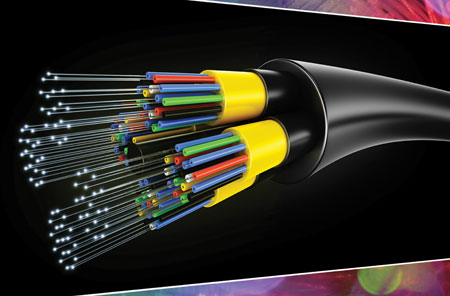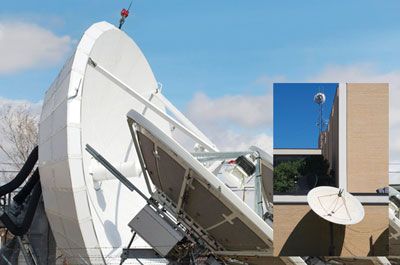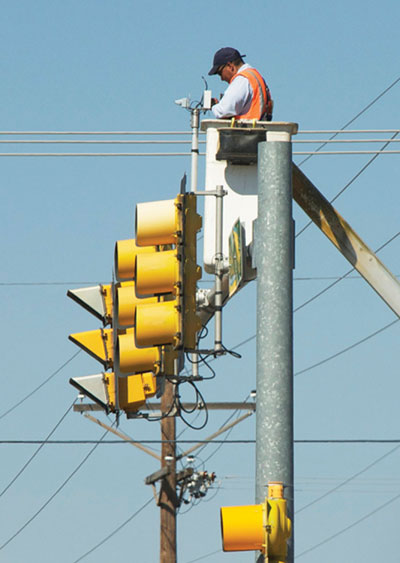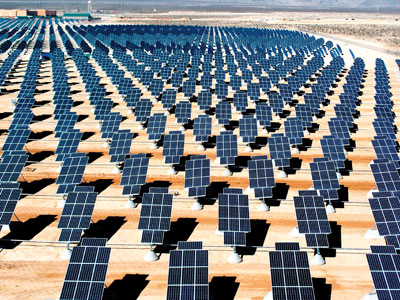 We seem to live in a world where technology changes weekly; we’re inundated with so much new hardware like smartphones and tablets and broad concepts like “Smart Grid” that it’s difficult to keep up-to-date. Everybody seems to think “fiber optics” is a new technology, too, although some of us have been involved with the technology for over thirty years!
We seem to live in a world where technology changes weekly; we’re inundated with so much new hardware like smartphones and tablets and broad concepts like “Smart Grid” that it’s difficult to keep up-to-date. Everybody seems to think “fiber optics” is a new technology, too, although some of us have been involved with the technology for over thirty years!
Without these last three decades of fiber optics, we’d be missing a lot of communications we depend on — like the Internet, mobile smartphones or cheap worldwide phone calls. Computer networks would be slower and more expensive. Cities would not be able to ensure security with video surveillance or to manage traffic with smart traffic lights. If it involves data and/or communications, it probably involves fiber.
Within the same thirty years, think how many other technologies have been introduced, peaked and become obsolete: VCRs, CDs, desktop PCs, and more. Yet fiber optics has slowly matured, becoming the preferred medium for most communications.
Along the way, all those who install cabling have embraced fiber technology. I started training NECA electrical contractors how to install fiber optics over twenty years ago. Today the majority of these contractors install fiber optics for the same customers they have always served. Installers of data cabling, security systems, building management systems or just about any cabling inside buildings or out have been trained in fiber optic installation.
Thankfully, we rarely hear “fiber optics is expensive, hard to install and fragile because it’s made of glass” any more. On the other hand, fiber has become so common, we sometimes don’t hear about some of the more important uses of the technology and how it facilitates many other technologies.

Photo 1. Telecommunications. Photo courtesy of John Watson
Let’s start with data centers. All that Internet data that creates billions of web pages or enables “cloud” computing has to be stored somewhere and made easily accessible — over fiber optics, of course. What we call a “data center” is really a “data warehouse” with shelves of servers that find and distribute the data and disk storage from many terabytes of data. A typical data center will have thousands of links connecting servers to storage and consume megawatts of power.
Increased Speed
Speed and power are the keys to data center networks (sometimes called SANs or storage area networks). 1 gigabyte Ethernet is being phased out for the 10 gigabyte version, and 40 and 100 gigabytes are becoming available. Copper cabling was OK for gigabyte links, but its development has been five years behind fiber at 10G and it’s not seriously being considered for 40 to 100G. Besides the bandwidth advantage, fiber consumes about ⅕ as much power per link as copper at 10G, and power consumption is a big issue for data centers.
Cellular Phone Networks
You are probably already addicted to smartphones or tablets and depend on cellular phone networks for these mobile devices. Cellular phones have always connected into the worldwide phone network that is based on fiber for long distance and metropolitan links. The growth in mobile data use is staggering. In its first 3½ years on the market, the iPhone alone caused an 8000% growth (that’s 80 times) in AT&T’s mobile network traffic. To meet traffic demand, cellular towers have been converting copper or digital radio to fiber connections to allow more radio bandwidth for user connections.
I’m sure you’ve noticed the proliferation of antennas on cellular towers to meet this demand for cellular bandwidth. Each of those antennas requires a connection to the base, typically with large coax cables running up the tower. These are being replaced with fiber, too, using composite cables that carry copper conductors as well as fiber, providing power and connections to all the antennas with a much smaller, less costly cable.
Faster Data

Photo 2. Traffic signal. Photo courtesy of John Watson
Besides widespread use of those smart mobile devices, we’ve increased our consumption of data in the home too, with Internet video being the fastest growing source of traffic. Streaming video, led by Netflix, now accounts for the bulk of Internet traffic. Video consumes vast amounts of bandwidth; just think about streaming a movie over your Internet connection that would fill a 4–5 gagabyte DVD!
To keep up with consumer demand, fiber is being brought closer and closer or even all the way to the home. CATV was an early adopter of fiber since it increased system reliability as well as allowing the first broadband Internet access using cable modems. Using the latest cable modem technology, DOCSIS 3, CATV can deliver Internet access up to 100 megabits/s or more.
Telecommunications companies (Telcos) are still trying to catch up with CATV for Internet access. Most telcos continue to use their old copper wires to connect the home but are installing fiber closer and closer to the home. Copper is limited in bandwidth by physics; longer links of copper telephone wire have considerably less bandwidth than shorter ones. While technology called DSL (digital subscriber line) can provide 10–40 megabits per second connections, it requires “clean” copper wires. Many homes in the U.S. have older copper that has deteriorated over the years, making DSL problematic. One telco guy I know says we’ve already mined all the copper we can for DSL — it’s time to convert to fiber.
FTTH Networks
And it’s fiber to the home (FTTH) that is the long-term solution for home connections. With fiber, you have virtually infinite bandwidth. Fiber costs more but has two potential paybacks: (1) the potential to sell consumers more services and (2) lower maintenance costs. In addition, new technology like passive optical networks (PON) that split one fiber link to serve up to 32 users can save lots of money, making fiber only slightly more expensive than DSL.
In 2005, a Telcordia survey said that FTTH could pay for itself in lower maintenance costs compared to the high maintenance required by older copper wires. Verizon took this report to heart, creating FiOS, the biggest FTTH system in the U.S., and saving billions of dollars in maintenance costs by replacing their aging copper cable plant with fiber. Converting customers from just POTS (plain old telephone service) to HDTV and Internet users added billions more in revenue too.

Photo 3. Fiber has been used by utilities for years. Photo courtesy of John Watson
Today, there are about 800 FTTH projects being built in the U.S. Google made waves in the industry by announcing they would build a gigabyte FTTH network in a U.S. city as a demonstration project. Kansas City (KS+MO) was chosen for this project that is now being installed. While Google was talking about gigabyte FTTH, Verizon actually demonstrated it in their FiOS network in Massachusetts. But the city of Chattanooga, Tennessee, outdid everybody, installing a citywide gigabyte FTTH network using the local electrical utility network.
Chattanooga’s gigabyte FTTH network truly illustrates the reasons for cities to install FTTH. The local telco and CATV companies did not do the work, but the city electrical utility had been looking at reading meters online. It was an easy — I said easy, not cheap — expansion to offer broadband Internet. But the city’s commitment to providing broadband helped convince Volkswagen to bring their U.S. manufacturing plant to Chattanooga, creating 3000 jobs initially and 2000 more in the future.
Other regions and cities are also promoting FTTH for its ability to attract high-tech jobs. A consortium of college towns has founded “Gig-U,” an organization dedicated to bringing gigabyte FTTH to their cities to attract tech companies. A startup has even received $200 million to provide those networks.
FTTH networks must have fiber equipment at every home (or subscriber, if in an apartment or condo building) to interface to the customer’s phone, TV and computer. These optical-to-electrical conversion boxes require power and connection to the customer’s devices, either through current cabling or cables installed by the system operator. Power generally is by AC power cubes although more complex uninterruptible power supplies are sometimes used to allow customer connections during power outages.
Municipal Networks
Cities are installing municipal networks for many other uses than FTTH. Municipal networks are expanding rapidly because they encompass many types of services, not just broadband Internet.
Cities and suburbs are installing communications systems to connect administrative, public safety and other city offices. They are installing surveillance cameras for security and traffic monitoring. Traffic signals are being monitored and controlled to improve traffic flow to save energy. Schools are being connected to provide high speed Internet to students and school administrations.
Wireless (WiFi) systems are being installed for both private municipal use and public access. Utilities are expanding their communications systems to increase efficiency and to read meters remotely. Many cities are also realizing that they can lease “dark fibers” to phone or CATV companies as well as other companies that desire high-speed connectivity.

Photo 4. Utilities with long distance companies to install fiber along high voltage lines. Photo courtesy of John Watson
While consumer demand for broadband drives much of the growth in fiber optics, many other applications are growing as well. The buzz about “Smart Grid” refers to the work being done to increase the efficiency and security of the power grid. Just imagine the scope of the problem. In the U.S., there are over 2000 utilities generating power and hundreds of thousands of photovoltaic solar systems pumping power into the U.S. power grid.
Keeping this network under control is a massive job. Last year here in Southern California, we had a power outage because a tech at one small generating station flipped the wrong switch and put 5 million users in the dark for the evening. Making a power grid more efficient requires communications and that’s done on fiber.
Utilities and Optical Power Ground Wires
Fiber has been used by utilities for decades. Utilities were among the first to recognize the advantages of fiber as a non-conductive communications cable that could not only connect generating or distribution facilities but even monitor high-voltage lines using fiber optic sensors. Utilities partnered with long distance companies to install fiber along high-voltage distribution lines, with the communications companies selling telecom services and the utilities getting free links for their use.
Together they pioneered an extremely useful cable design, a high-voltage transmission line with fiber in the center for communications. It’s called optical power ground wire (OPGW) and forms the communications backbone in many areas of the country. Since fiber is totally immune to electromagnetic interference, power lines can carry massive amounts of communications signals at much lower costs than when fiber cables must be installed independently.
Fiber is a major component of smart grid technology. One college we know is developing a smart grid program with a major utility, and fiber represents about one-third of the course. And as utilities add more fiber to manage their systems, they get closer to the home, eventually reaching what one person called FTTM — fiber to the meter — and they can offer gigabyte connections to every home.
Industrial Installations
Fiber has also made big inroads into industrial environments. Over the last few decades, most machines have become automated with computerized controls that send data back to computers that analyze and manage the factory floor. Auto plants use fiber for welding robots, critical assembly and inspection tools, control of other machinery and the assembly lines. Aluminum smelters are another place where fiber is popular because they use extremely high electrical currents in processing the aluminum that interferes with other communications media. Video cameras monitor the activity of workers, machines and materials. HVAC has become computerized in part to improve the factory environment but also to reduce energy costs.

Photo 5. In the desert in the southwest, solar generation stations are being built
Most factories have in common large physical plants and a harsh environment.
Industrial fiber optic cable plants usually require more protection than in commercial buildings. Cables are often run in metal conduit and terminations are made in sealed enclosures. Cables are sometimes run along the roof and dropped to floor locations, so extra support for the vertical runs can be an issue.
Business and Government Uses
Perhaps the most complex fiber optic cable plants are in the biggest buildings like airports, convention centers and other government facilities. These buildings are likely to include networks for phones and computers, indoor antennas for mobile WiFi and cellular devices, security cameras and entry systems, building management systems and entrance facilities with connections to many outside communications systems.
These large buildings have been used for some interesting experiments in cabling and networks. Here in the U.S., some contractors have been using FTTH PONs [fiber to the home, passive optical networks] scaled for use in buildings. A PON network has many advantages including easier installation with only one fiber per user, higher bandwidth capacity and lower cost. The cost is even lower than a copper network because of the network architecture and market volume; with millions of units having been built and installed in FTTH networks. Perhaps the two biggest advantages of a PON network in a building are easier network management and security. PON networks are scaled to handle millions of users so network management in a smaller building network is easy. And since it splits fibers to connect users using the same signal, it’s necessary to encrypt every user, increasing security.
A network architecture we saw recently in a foreign airport is making inroads into computer networks too. Called fiber to the office (FTTO), it uses a standard Ethernet architecture over fiber with small, inexpensive switches placed near the user’s desk and shared by four computers or VoIP phones. Besides replacing four big copper cables with one small fiber cable, it also eliminates the need for expensive telecom rooms on every floor of a building with their requirements for electrical power, AC and data-quality grounding.
Alternative Energy Systems and Fiber
Fiber has also become an enabler for energy. One of the earliest uses for fiber was in mines where it was used for its long distance capability and inherent safety since it does not involve electrical current in its transmission. Fiber was also used for energy exploration, allowing the connection of many seismic sensors over a large area on land and underwater remote vehicles to reach the deepest parts of the ocean (and discover the Titanic too). Pipelines rely on optical fiber running along their lengths for communications and monitoring for problems.
Perhaps the most interesting use of fiber in energy is in two growing fields, wind and solar power. Wind power requires careful monitoring of each tower to make it efficient as the wind changes and to connect it to the grid. Each tower is connected to fiber as part of the generation network.
Solar power is even more interesting. In the desert in the Southwest, several gigawatts of solar generation stations are being built. Unlike the typical small system that uses photovoltaic panels, these large systems combine hundreds or thousands of mirrors to focus extremely high power light to create steam that runs a generator. It’s really just like a nuclear power plant but the reactor is 93 million miles away — and much safer!
Some systems heat water or antifreeze to generate steam, but a new system uses plain old salt (NaCl) in the heat exchanger. The higher heat capacity of salt allows storing heat underground so steam can be generated during night hours, a big advantage over photovoltaic systems.
These solar systems require moving the mirrors continuously to keep the light focused properly. Every one of the mirrors spread out over hundreds or thousands of acres requires control and feedback, and that is provided by optical fiber. And of course the generators and heat exchangers require equally good monitoring and control, all on fiber.
How Fiber Impacts You
For electrical inspectors, most of what you need to know about fiber optics is in the NEC or on the Fiber Optic Association website (www.thefoa.org). We even have created with NECA an ANSI standard on fiber optic installation that describes what installing fiber optics “in a neat and workmanlike fashion” means. FOA provides the ANSI/NECA/FOA-301 Standard free to the industry. Contact FOA for your digital copy. But the proliferation of fiber uses in every aspect of today’s technical world means it’s harder to keep track of where the fiber is and what the fiber is doing.
Here at the Fiber Optic Association, the professional society of fiber optics, we try to track all the uses of fiber and help the industry keep up-to-date with our newsletters and websites. Most of our focus is on the designers and installers of fiber optic cable systems, but recently we’ve had requests from electrical inspectors for more information and even requests from IAEI chapters for seminars on fiber optics.
Generally, we send callers to our website or our online training website (fiberu.org) for free technical information online. For one chapter, the FOA sent one of our Master Instructors, Arnie Harris in Philadelphia, to speak. Arnie’s talk was well-received and we’re certainly willing to entertain more requests for seminars.














Find Us on Socials